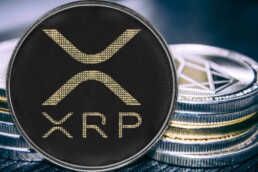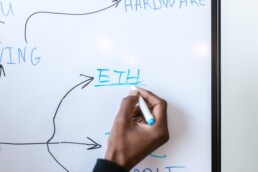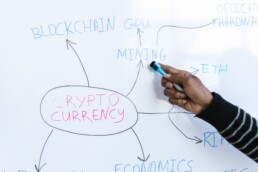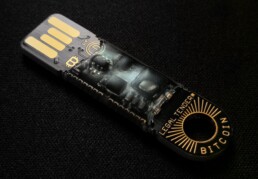XRP and Ripple
There is a coin in the cryptocurrency world that is considered a cryptocurrency when in fact it is not.
We are talking about XRP, created by the company Ripple. In common parlance XRP and Ripple have become synonymous, but the token's only name is XRP. This coin was not created with the idea of being a more functional alternative to Bitcoin, but to be a tool in the hands of the banking world by creating an alternative system to Swift.
XRP is not a real cryptocurrency because it is not totally decentralized.
In fact, Ripple began in 2012 as a system for transferring funds through a network for currency exchanges. In September 2018, Ripple was the second largest coin in the cryptocurrency market by market capitalization.
Ripple controls and manages XRP and has agreements with banks around the world. its code is open source and the value of the coin is affected by the value that is also assigned to the company.
Ripple was created solely to replace old systems such as swift, western union and moneygram with a cheaper system. Not all banks are connected to each other in the world with a single system. This forces banks to switch between different intermediaries in different countries, with long time and big cost for every transactions.
XRP is not created to be a store of value or to make transactions between economic actors in the real market but as a technical tool for specific banking actors or Payment Systems, companies, corporations, currency exchanges.
Because of its characteristics, Xrp cannot be mined but is a pre-mined currency. XRP is fast and scalable, in fact transactions in XRP take about 4 seconds versus 5-10 minutes for btc
XRP's wallet works with a minimum deposit of 20 XRP, an sistem created to avoid inordinate growth of accounts on its network for the sole purpose of clogging up the network and slowing it down.
The token is divisible up to 6 digits after zeros and some XRPs are destroyed after each operation, another system to protect the network. In the event of an attack, with thousands of useless transactions for the sole purpose of slowing down network, this system drains the accounts of the addresses that create the transactions.
Ripple's protocol is called rtxp Ripple Transaction Protocol and consists of pcs called validators that manage the network with their shared ledgers. Companies wishing to use Ripple's network must use gateways, which are points managed by banks and useful to those outside the network.
Ripple Labs was created only to offer banks various types of products, in fact RXTP is open source but the ripple products offered to banks are not and are created and developed only by ripple labs.
Ethereum
Vitalik Buterin has given to the world one of the platforms with one of the biggest potentials on the planet. Ethereum has a very interesting future ahead of it.
Ethereum, whose currency is called Eth, is not only on par with btc a currency for exchanging value, but it is a decentralized platform for creating complex applications. In fact, the goal of ethereum is to decentralize the Internet from the network giants of today.
Ethereum is a decentralized platform for the creation and peer-to-peer publication of smart contracts, or in short, contracts that are self-executing and self-fulfilling. The applications of these contracts are and will be of an enormous number and will cover Gaming and gambling, various contracts, certifications, voting, real estate records and much more.
Even the famous ICOs are actually very simple smart contracts tied to the written code base. This code makes the contract immutable once deployed on the network and after blockchain approval.
Complicated smart contracts have a very high inherent level of difficulty and a huge need for security. You have to create perfect programming and be sure that the contract does only what the programmer has decided. Always remember that Code is Law.
The principle behind Ethereum is that since it is a decentralized platform for program development, anyone can create a program that cannot be controlled by any person or group and that program will run on Eth's network. With a little study of Solidity, all intermediaries can be eliminated and developers can work directly on the Blockchain.
Ethereum was launched in July 2015 and has since become the second largest cryptocurrency by capitalization. Its potential is extremely interesting and deserves to be followed .
A lot of applications are being developed on the ethereum network, from DEFI to NFT tokens to decentralized exchanges that are used to exchange tokens of different types, on the same network, eliminating the trust problem of a centralized exchange.
Ethereum's ease of programming has meant that thousands of other coins, which we can call tokens or altcoins depending on the situation, have sprung up on its network.
Tokens can be defined as the tokens for slot machine, and there are different types of crypto tokens. If we take our cue from Finma, the Swiss regulator, we can define them into 3 categories.
- payment tokens not linked to other functions i.e. Bitcoin, Ethereum, Litecoin. These are real coins, born for value exchange.
- utility tokens that serve a single platform or digital service such as Ripple's XRP, or Binance's BNB, and can be exchanged outside their native platform.
- Investment tokens, which, on the other hand, represent asset values, such as shares in real assets, companies, revenues, or the right to dividends or interest payments. These tokens should be considered in relation to their economic function, in a similar way to shares or corporate bonds, or a derivative financial instrument.
How Cryptocurrencies Work
Few people know or remember, that cryptocurrencies originated as a derivative product of another invention. In fact, Satoshi Nakamoto had no intention of inventing another currency.
The most important part of his invention, when he gave the world the whitepaper of bitcoin or” A Peer-to-Peer Electronic Cash System" was that he managed to create a way to create a decentralized payment system. Throughout the 90s of the 20th century, attempts were made to create a digital system, but all these attempts failed miserably. But developing a system as if it were a peer-to-peer file exchange was the right choice
To set up a payment network you need accounts, user profiles and transactions. Easy to understand but then the biggest issue is to prevent users from spending the same money twice with different entities. To solve this, we use a central server that keeps track of all user balances. But if we do not have this authority or do not want a central entity to certify and monitor users, how do we solve the problem?
In a peer-to-peer network, every single node must have a list of transactions and check that they are valid. Most importantly, all nodes must agree with the approved transactions, because otherwise the network immediately collapses.
No one knew how to solve this network consensus problem until 'Satoshi's invention.
If we take away all the marketing and halo of mystery around cryptocurrencies, and go to the 'bones of their definition , we could define them as "a database with limited writeability within it that no one can change unless it meets specific conditions." This sounds like the definition of a bank account in any bank.
To give a correct definition, cryptocurrencies are a method of exchanging value based on internet technology, which use cryptography to carry out financial transactions that are decentralized, transparent and immutable thanks to blockchain technology.
In currencies such as Bitcoin, the database is managed by the various nodes in the network. Each node has a shared ledger inside which the values of each account and the transactions made are put. Transactions are files that say Gigi gave Y btc to Pancrazio and this transaction was signed by Gigi's private key and then sent to the network.
The transaction is known immediately by the network but it takes some time to get it approved. Approval or rather confirmation of the transaction is one of the key parts of the technology. A confirmed transaction is immutable.
Only miners can confirm transactions, through the process called Mining. Mining involves closing blocks of transactions in the blockchain. Before doing this, however, miners must check the transactions, approve them and enter them into the network. When they are confirmed they become part of the blockchain. And to do this they receive other cryptocurrencies as payment.
Technically anyone can become a miner, since there is no central authority that can approve us or not. Of course it takes security rules to make sure that the network is not destroyed by those who have an interest in its demise. In the case of Bitcoin, the system is called proof of work, which is based on the SHA 256 Hash Algorithm and involves the miner finding a hash, to connect the closing block with the previous block. We can define it, to keep it simple, as a cryptographic puzzle to be solved. Solving it, the reward will be some bitcoins. And this is the only way to create new bitcoins.
Cryptography, therefore mathematics, makes the system secure.
So we are not talking about trust between humans, which can be bought or blackmailed. You cannot blackmail or kidnap the child of a mathematical operation.
Some of the most interesting properties of cryptocurrencies are:
Irreversibility: no one after confirmation can cancel a transaction. Wrong address? Nothing can be done about it. Your pc was stolen with the private key? Nothing can be done. The safety net is not there.
Pseudonymity: no account or transaction is connected to real life. However, if you have done a KYC somewhere, your identity is traceable.
Fast and global: transactions are virtually instantaneous, the speed of confirmation depends on the coin, but of ranges from second to 10 min in Bitcoin. They have no borders though since the network is global.
Secure: As long as you own the private key you are safe. Big coins are unlikely to be hacked unless there are deliberate bugs.
Permissionless: you don't have to ask anyone for permission to use your coins. No one can stop you from using them.
Limited Number of Coins: A good portion of cryptocurrencies have a limited supply, such as Bitcoin with its 21 million. In contrast, DOGE has an unlimited supply with a huge daily production. The limited supply is obviously an advantage in terms of maintaining value.
Think about how useful these properties can be to citizen freedom.
The downside of blockchain
By now we understand, the blockchain is a public ledger. So it's a ledger that everybody can look at, if they know how.
So it's a list of who owns what. Even if pseudonymous as Bitcoin, with a KYC within the network, I can know that my neighbor has a significant amount of money or not.
With normal bank accounts this does not happen, we do not know how much our precendent neighbor owns unless he tells us himself or someone lets us know. Not to mention possible hacks of the bank's databases, which should not happen.
Let us start with a basic principle, it is not smart to tell to everybody about our possessions. Whether you are talking about cryptocurrencies or fiat currency accounts. My preference is to always be on a low profile, without flaunting one's possibilities even if they are limited. The personal safety factor should always be understood and considered. There are times and places to flaunt one's favorite Rolex.
The blockchain, unfortunately, as it was conceived and created, has a big privacy problem, which in the coming years will absolutely have to be addressed and solved.
What is a blockchain? Learn more here.
Double Spending
Today we are going to learn what double spending is.
Double spending is the manipulation of the blockchain of any cryptocurrency in order to spend the same amount of coin several times, sending this coins to different addresses.
Let's take an example on the bitcoin blockchain.
If we have only one bitcoin on our wallet, and we send it to Marco, this will be awaiting confirmation in the network mempool.
Immediately after closing the transaction to Marco and before waiting for the confirmations, we will send the same amount to Giorgio, and this transaction will also end up in the unconfirmed transaction pool.
When these transactions are checked by the miners, the second transaction will be rejected as invalid and impossible to carry out.
In case of simultaneous sending of several transactions, we will have to wait for the 6 confirmations to understand which of the two transactions will be rejected and which will not
From one wallet to another - The transaction of a Bitcoin
In this article we will see what happens from when we send a bitcoin to when it is received from another address.
There are 3 main parts within a transaction, and these are:
Signing
Broadcasting
Confirming
Let's start from the first one, the signing.
Now, by pressing the send button we are telling the wallet to send the selected bitcoin sum to the address indicated in the space provided.
The wallet then creates a transaction, which is actually a message containing the data of who sends, who receives and how much is sent.
Once this is done, a unique digital signatures is created by mathematically mixing my private key, that is the private key of the sender.
The private key as we know, is a long series of letters and numbers that acts as a password for your bitcoins.
Whoever knows the private key has control of these bitcoins, so you must protect it in every way.
The digital signatures is proof that I have this private key along with my public key.
Remember that each transaction creates a different digital signatures.
After signing the transaction, the system creates a file containing the digital signatures and the transaction message.
This concludes the first step on signing.
In the second step, the broadcasting, the wallet sends the file to the computers that mine the blockchain or have a copy of it.
These computers are known as NODES and each node that receives the file checks it to understand that it is legitimate and correct.
In particular, check that who is sending some coin needs have the funds in his wallet and then confirm the validity of the digital signatures.
Once confirmed as valid, this file is sent to other nodes which repeat the verification process.
When a node receives the file, it keeps it in an area called Mempool or memory pool.
This is a space dedicated to valid but not yet confirmed transactions.
Now let's move on to the status of our transaction, Block explorer is software or a tool on a website to check the status of transactions and navigate the blockchain.
We can check the holdings of all bitcoin addresses, check all transactions and have statistics and information on the network in real time.
If we check our transaction right now, we will see it marked as unconfirmed. this means that our transaction is not yet part of the blockchain.
It is defined as zero confirmation transaction.
In this state the transaction could still be canceled or postponed and we have no guarantees that it will be included in the blockchain.
If you sell products and services, never accept an unconfirmed transaction as proof of payment.
If you remember, when we talked about mining, we said that miners group transactions to create a block of the blockchain and of course miners will take the transactions that will be more profitable, there is a limit to the number of transactions.
So the miners compete with each other to create the blockchain block and this competition is based on mathematical calculations.
The greater the computational power the greater the chances of victory.
When a miner wins the competition, all transactions that are in that block are considered confirmed.
Miners write the history of bitcoin transactions and a block is created every 10 minutes.
When we go back to check our transaction, if it is written inside a block, it will be marked as with 1 confirmation.
Confirmations will grow as block creation increases.
The transaction will be fully confirmed with 6 confirmations and without any possibility of cancellation.
The transaction will now be received and it will unmodifiable.
How to get started with bitcoins!
what are the steps to get to know Bitcoin?
Step n1 Education
You have to understand the basics of bitcoin and what revolves around it, studying our guide and seeing our videos is a good starting point.
You have to understand why people appreciate this new technology, what gives it value and why, what is behind it and what are the ideas that led to its creation.
Step n1 is useful but not fundamental, in the sense that you can buy bitcoins even without knowing anything about it.
The second step is to gain experience with a purchase.
Create a wallet, sign up for an exchange and start moving your bitcoins.
Get experience through small transactions and expect to spend 100 euros that you can consider lost.
Then try to turn some of these bitcoins into ethereum and experience that too.
The third step will be to stay updated on the technology and the market.
And always follow us.
Bitcoin Digital Signatures
Today we explain the meaning of the term Digital Signature towards the bitcoin blockchain.
First, to send any amount of bitcoins to my wallet I have to prove that I am the owner of the private key.
Digital signatures will give you this proof of possession, obviously without making my private key public.
When I submit a transaction, it is mathematically mixed with my private key to create the digital signatures.
When the miners will go to validate my transaction, the digital signatures together with my public key will allow the miners to validate the transaction, guaranteeing possession of my bitcoins and avoiding double spending.
Digital signatures are different every time you sign a transaction, so they will be different for every send to any address.
5 golden rules to buy bitcoins between users!
the issue of the sale and purchase of bitcoin between individuals.
It may happen that you decide to sell or buy bitcoin from a private individual for various reasons, the important thing is to always be careful that on the other hand there isnt a scammer or an attacker on the seller.
Let's start from the point of view of those who want to buy.
The steps to take are:
1 checks the credibility of the seller:
There are groups and sites where individuals decide to sell their bitcoins.
On these sites there are always reviews and past experiences.
You have to check the credibility of these people and how they approach each other in the various chats.
Trust your instincts and Always start with small amount of money to buy.
Also try to use google by searching through the various pages. Maybe you will waste time or maybe you will save your money and life.
2 documents everything to avoid fraud:
Chat with this person, ask questions and have them explain precisely how the exchange will take place.
Don't leave anything out. Prefer emails or written chats, avoid phone calls or record them.
Remember that you need material to help you prove fraud.
3 wait for the first confirmation before paying
Remember that Bitcoin needs 6 confirmations to go from one address to another, and it generally takes 10 minutes for the transaction to be written in the first available block.
Obviously assuming that the transaction fee does not make him pass to the next one and so on ...
4 uses an escrow:
What is an escrow?
From wikipedia: A guarantee deposit is a legal agreement in which a real or virtual asset is deposited by one party in the account of a neutral third party, until the other party fulfills the contractual clauses. Upon fulfillment of the clauses, the agent will deliver the deposited asset to the other party.
A 3rd party will protect your money from possible fraud.
5 Where to trade:
You can choose to do the exchange in a public place, in a bar or without meeting the person on the other side.
It's all up to you, but don't put yourself in danger.
Avoid hidden places and stay around people.
Advice For those who want to sell:
The advice above can also be applied to the seller's part.
Be careful with buyers. It could be an attempted assault and it wouldn't be the first time a salesperson has been beaten up and robbed.
Be careful
Is Bitcoin Anonymous??
Today we are going to talk about bitcoin and his anonymity, the thing that everyone talks about but no one knows about.
Let's start from a fundamental point, bitcoin is completely traceable and transparent thanks to the blockchain network but bitcoin is not completely anonymous .
Bitcoin is pseudonymous.
In fact, the address of your wallet is your identity on the blockchain but if this address is connected in some way to your document, your identity is revealed.
Think for example of when you did a KYC on some exchange, and from this exchange you sent funds to your long-term wallet.
Here at this moment your pseudonymy has been lost and anyone will know how many bitcoins or other coins you have on that address.
If you want to remain totally anonymous you will have to take the necessary measures












